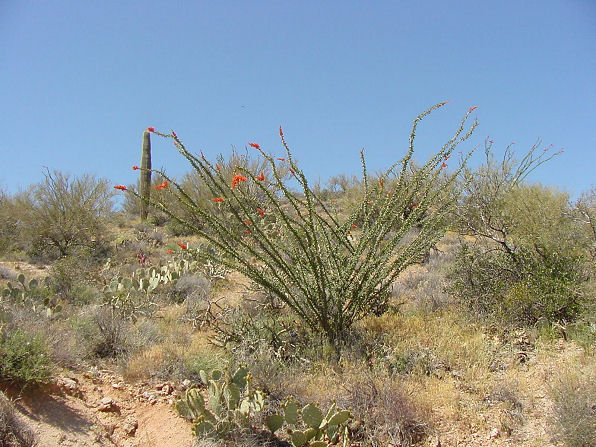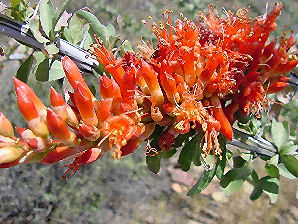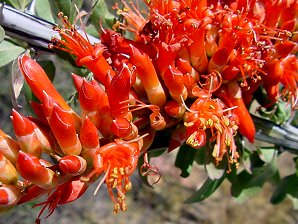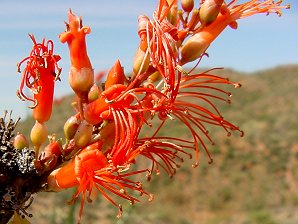Arizona Wild Flowers
Pictures, Photos, Images
Descriptions, Information, Reviews.
Ocotillo, Fouquieria splendens.
We Are Proud Of Our SafeSurf Rating!
Click On Any Of The Following Links By Amazon.Com
For Books, & Videos About Wildflowers Of Arizona & The Southwest USA. No Obligation!
 |
| Ocotillo, Fouquieria splendens. Plant. |
|---|
 |  |
| Ocotillo, Fouquieria splendens Not Cactus Since It Grows True Leaves. | Spiny Stems With bundles Of Seasonal Leaves At Each Spine. |
|---|---|
 |  |
| Fouquieriaceae (ocotillo family). | Ocotillo Flowers Close Up. |
 /
/

Ocotillo.
We wish to thank Wikipedia, the free encyclopedia for some of the information on this page. We share images and information with Wikipedia. The Ocotillo often is mistaken for a cactus because of the spines covering its branches. But these spines are actually the stems of the plant�s first leaves, and since true cacti don�t have leaves, the ocotillo is not a cactus. It is a close relative of the Boojum tree (Idria columnaris) which is native to isolated areas of Baja California and Sonora, Mexico. The Ocotillo is actually a woody shrub 10 to 20 feet (3-6 m) tall. Its long, thin, nearly unbranched, spiny stems arise from a very short trunk known as a caudex. The stems range from nearly vertical to widely-spreading. Very dense spikes of tubular, red to red-orange flowers sprout from the stem tips in the spring. The flowers are about an inch in length. They contain nectar that attracts many local and migratory hummingbirds. The flowering season can start as early as in Mid - February at the lower elevations of the desert habitats, and as late as in Mid May in the grassland and woodland habitats. In the higher elevations some Ocotillo will bloom again during the late summer or fall. They remain in bloom for about a month. The Ocotillo does not store a great deal of water, but instead it has adapted over centuries to adapt to times when it does not have water available. The ocotillo only grows leaves after a rain, and then when the ground is dry again, the Ocotillo drops it's leaves. These oval, 2-inch leaves grow in bunches above the spines. Their waxy coating helps protect them from losing moisture. When the leaves drop off, and the scaly green bark turns wood brown, Nothing but spines are left behind to adorn the branches. Ocotillo can be used for fencing, house walls, and ramada roofs by Native Americans and ranchers. We have often seen this done in Mexico. The cut, buried stems often root, creating a living fence.
Quick Notes:
Height: Perennial Up To About 10 - 20 Feet Tall.
Flowers: Red tubular up to about 1" long in bunches or clusters from 8" to about 12" long, located at the tips of each branch or cane. . Regular; five united petals forming 5- lobed tublar corlooa, five sepals with 10 to 17 protuding stamens, superior ovary. bloom during May and June. Clustered near the ends of branches, the blossoms open during cooler desert evenings and close again by the next midday.
Flowering Time: Mid - February at the lower elevations of the desert habitats, and as late as in Mid May in the grassland and woodland habitats. In the higher elevations some Ocotillo will bloom again during the late summer or fall.
Fruit: Three celled capsule.
Branches: Ocotillo can have up to about 50 branches which seem to come from a stalk at ground level.
Leaves: Green, Oval, up to about 2" long. Alternate. simple, in clusters in axils of spines.
Found: According to the USDA it is native to the USA (AZ, CA, NM, NV, TX). It is common in most of the Sonoran and Chihuahuan deserts and extends north into the southern Mohave Desert, south into central Mexico, and east into central Texas. Found in mexico in northern Sonora, northern Chihuahua, Baja Norte, Baja California, & Coahuila.
Hardiness:
Soil pH requirements:
Sun Exposure:
Elevation: 0 - 6,000 Feet.
Habitat: Desert well drained slopes and flats, rocky bajadas. They occur at their highest elevation ( 6,000 feet) on limestone, and at their lowest elevation ( sea level ) on granite. Also used as a xeriscape landscape plant!
Miscellaneous: Flowering Photos Taken May 11, 2003 near Lake Pleasant.
|



We Are Proud Of Our SafeSurf Rating!
Click On Any Of The Following Links By Amazon.Com
For Books, & Videos About Xerioscape Plants Of Arizona & The Southwest USA. No Obligation!
Back To Arizona Wild Flowers Home Page
Back To Arizona Wild Flowers, Red Flowers, Page One.
Back To Arizona Xeriscape Landscaping Main Page.
Back To Xeriscape Succulents Page One.
Back To DeLange Home Page
© 1966 - Present, Audrey, Eve, & George DeLange
| © 1966 - Present, Audrey, Eve, & George DeLange |


